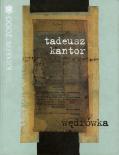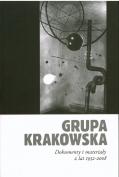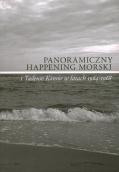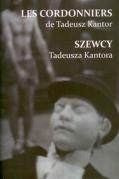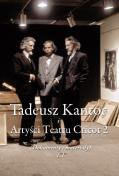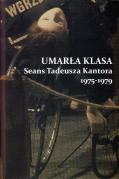Chronologies of Tadeusz Kantor’s life and work
There have been numerous articles, books and academic studies describing the achievements of the creator of the Theatre of Death. The artist’s activities have frequently become the subject of conferences and symposia. The research into all activities of Tadeusz Kantor, conducted by Cricoteka, still allows for discoveries of unknown documents and materials which expand and complement the knowledge on the subject. They focus primarily on completing and expanding the chronology of the artist’s life and his artistic work, and the results of these efforts are published in a book form.
The first such study was available in 2000 in a volume entitled Tadeusz Kantor. Wędrówka [Tadeusz Kantor. Chronology] published on the occasion of the Festival of Tadeusz Kantor. It constitutes a chronologically structured list of the most significant events in the life of the artist. In a way, this study has become the base, the starting point for further detailed research. Starting from the year 2000 there have been other publications of this type, which are, in fact, more detailed extensions of Chronology.
In order to understand the meaning of the work focused on such detailed examination of Tadeusz Kantor’s life, it is important to remember that he is considered to be one of the greatest Polish artists of the twentieth century. Thanks to his numerous tours and peregrinations around Europe and around the world, he was able to come into direct contact with new trends in art, which he later developed in Polish conditions. He drew inspiration from Constructivism and Dadaism, informel painting and Surrealism, he was fascinated with conceptual art and happening. Kantor gained worldwide fame mainly as a result of the performances of his Cricot 2 Theatre, which were part of the Theatre of Death cycle.
It should not be forgotten, however, that Kantor was also one of the most important and most active leaders of artistic life in post-war Poland. Shortly after World War II, he co-founded Grupa Młodych Plastyków [Group of Young Artists] and then, during the thaw, he helped to revive the pre-war Grupa Krakowska [Krakow Group]. It was also his initiative to create the Krzysztofory Gallery, one of the first post-war galleries displaying contemporary art. Already during the occupation, he created an underground experimental theatre in Krakow which united the artistic circles. Its continuation was the Cricot 2 Theatre, formed in 1955, which referred to the tradition of the pre-war avant-garde theatre of artists – Cricot (1).
The main form of Kantor’s artistic expression was painting and theatre, but it did not stop him from experimenting with other disciplines. For over fifteen years he worked as a decorator and set designer in institutional theatres, was involved in abstract film and organised a number of paratheatrical activities. He carried out many of the activities almost simultaneously – he held rehearsals for his subsequent performances while preparing exhibitions, organising happenings and taking active part in social and cultural life.
Tadeusz Kantor’s work stemmed closely from his life, feelings and experiences. Moreover, the artist consciously drew on the rich repository of his personal history, often making it the protagonist of his plays, happenings, works of art. His work was extremely personal and frequently referred to the events, places and people whom he had met on his way. Therefore, in order to fully understand the art of Tadeusz Kantor, it is essential to know the time in which he lived and worked, and to realize the complexity of the many connections and relationships that concerned him. This opportunity is provided by the publications developed by Cricoteka.
The different partial chronologies are generally dedicated to a selected period of Tadeusz Kantor’s activity or focus on a specific theme of his work. The artist’s family history, Tadeusz Kantor’s school years, his life and work during the German occupation, the story of Cricot (1), the first years of Cricot 2 activities, the details of the formation and implementation of the famous Panoramic Sea Happening or the little-known Parisian production of Szewcy [The Shoemakers] by Witkiewicz are just some of the discussed topics.
Having determined an interesting time period or theme and relying on the knowledge and materials preserved in the archives of the Centre, further exploration can begin. The institutions where the artist worked and lived (both in Poland and abroad), libraries, public and private archives provide materials for our queries, whose purpose is to collect the highest number of the smallest details, testimonies and documents of the period of interest. If possible, contacts are established with individuals or families of people who personally knew Kantor – his co-workers, critics, directors, artists, translators, people associated with the environment in which the artist functioned. Their memories and all kinds of keepsakes very often constitute a great source of knowledge and complementary materials which enrich our publications. All newly acquired materials are analysed and interpreted. They serve as the basis for clarifying questionable dates of events and interpreting vague facts from Kantor’s life. Sometimes they also assist in trying to determine the actual time of origin of certain projects and texts of the artist, which were often re-edited and backdated by him. There appear newly discovered facts constituting evidence of Kantor’s unrealised plans and reasons for their failures. Information on the well-known activities of the artist is developed in more detail.
After the selection of all collected materials referring to a given period, the chronology is ready to be prepared – under successive dates (mostly daily) there is matching information on the events from the artist’s life – both well-known and brand new facts, discovered after many years.
The pages of our chronologies also include numerous references to people from Kantor’s environment and their activities, which he had witnessed or participated in and which naturally influenced him. There is also information describing the political situation at the time (both in Poland and in the world), records of significant events from general cultural life of those days, etc. By following Kantor’s subsequent activities we learn what happened concurrently in the world of Polish and international painting, theatre and broadly defined art. All the above presents the artist and his work in a broad historical and cultural context.
The various publications, in addition to chronologies, contain supplementary materials – mostly published for the first time – such as photographs, memoirs and texts recovered after many years or written specifically for the book. They are free of direct editorial commentary, providing the reader with great opportunities. Left alone only with the facts, devoid of analysis and interpretation, the reader can acquaint himself with them and draw his own conclusions, forming his own image of Tadeusz Kantor and the reality in which he lived and worked.
Justyna Michalik
So far the publications uinclude (in Polish):

